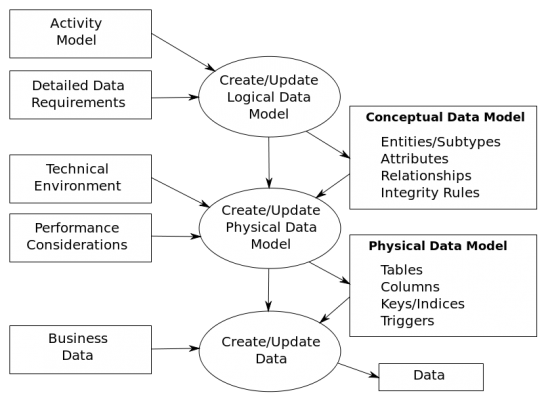Data Modelling: Difference between revisions
Jump to navigation
Jump to search
mNo edit summary |
mNo edit summary |
||
| Line 3: | Line 3: | ||
Data modeling is a process used to define and analyze data requirements needed to support the business processes within the scope of corresponding information systems in organizations. Therefore, the process of data modeling involves professional data modelers working closely with business stakeholders, as well as potential users of the information system. There are three different types of data models produced while progressing from requirements to the actual database to be used for the information system. | Data modeling is a process used to define and analyze data requirements needed to support the business processes within the scope of corresponding information systems in organizations. Therefore, the process of data modeling involves professional data modelers working closely with business stakeholders, as well as potential users of the information system. There are three different types of data models produced while progressing from requirements to the actual database to be used for the information system. | ||
== Strategic Concepts == | |||
* [[wikipedia:Balanced_scorecard| Balanced Score Card]] | |||
* [[wikipedia:Decision_Tree|Decision Tree]] | |||
* [[wikipedia:Flowchart|Flowchart]] | |||
* [[wikipedia:Mind_Mapping|Mind Mapping]] | |||
* [[wikipedia:Strategy_map|Strategy Map]] | |||
* [[wikipedia:Value_Chain|Value Chain]] | |||
== UML 2 Models == | |||
* [http://www.sparxsystems.com/resources/uml2_tutorial Sparx Systems] UML 2 Tutorials. | |||
* Structural Modeling Diagrams | |||
** Package diagrams are used to divide the model into logical containers, or 'packages', and describe the interactions between them at a high level. | |||
** Class or Structural diagrams define the basic building blocks of a model: the types, classes and general materials used to construct a full model. | |||
** Object diagrams show how instances of structural elements are related and used at run-time. | |||
** Composite Structure diagrams provide a means of layering an element's structure and focusing on inner detail, construction and relationships. | |||
** Component diagrams are used to model higher level or more complex structures, usually built up from one or more classes, and providing a well defined interface. | |||
** Deployment diagrams show the physical disposition of significant artifacts within a real-world setting. | |||
** Profile diagrams provide a visual way of defining light-weight extensions to the UML specification. UML Profiles are often used to define a group of constructs with domain-specific or platform-specific properties and constraints, which extend the underlying UML elements. | |||
[[image:Data_Modelling_Overview.png|thump|550px|right|Data Modelling Overview]] | [[image:Data_Modelling_Overview.png|thump|550px|right|Data Modelling Overview]] | ||
| Line 12: | Line 32: | ||
* [http://www.oracle.com/technology/products/designer/index.html Oracle Designer] | * [http://www.oracle.com/technology/products/designer/index.html Oracle Designer] | ||
* [http://www.silverrun.com Silverrun] | * [http://www.silverrun.com Silverrun] | ||
* [http://www.sparxsystems.com/products/ea/index.html Sparx Systems] Enterprise | * [http://www.sparxsystems.com/products/ea/index.html Sparx Systems] Enterprise Architect (Windows, Mac OSX with [http://www.codeweavers.com CodeWeavers] CrossOver). | ||
== See also == | == See also == | ||
Revision as of 18:03, 22 August 2014
Data Modelling in software engineering is the process of creating a data model for an information system by applying formal data modelling techniques [1].
Data modeling is a process used to define and analyze data requirements needed to support the business processes within the scope of corresponding information systems in organizations. Therefore, the process of data modeling involves professional data modelers working closely with business stakeholders, as well as potential users of the information system. There are three different types of data models produced while progressing from requirements to the actual database to be used for the information system.
Strategic Concepts
UML 2 Models
- Sparx Systems UML 2 Tutorials.
- Structural Modeling Diagrams
- Package diagrams are used to divide the model into logical containers, or 'packages', and describe the interactions between them at a high level.
- Class or Structural diagrams define the basic building blocks of a model: the types, classes and general materials used to construct a full model.
- Object diagrams show how instances of structural elements are related and used at run-time.
- Composite Structure diagrams provide a means of layering an element's structure and focusing on inner detail, construction and relationships.
- Component diagrams are used to model higher level or more complex structures, usually built up from one or more classes, and providing a well defined interface.
- Deployment diagrams show the physical disposition of significant artifacts within a real-world setting.
- Profile diagrams provide a visual way of defining light-weight extensions to the UML specification. UML Profiles are often used to define a group of constructs with domain-specific or platform-specific properties and constraints, which extend the underlying UML elements.

Tools
- Sybase PowerDesigner
- Embarcadero ER/Studio
- Oracle Designer
- Silverrun
- Sparx Systems Enterprise Architect (Windows, Mac OSX with CodeWeavers CrossOver).